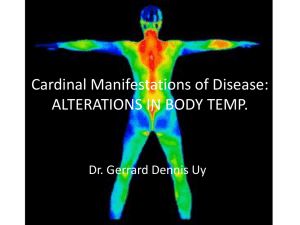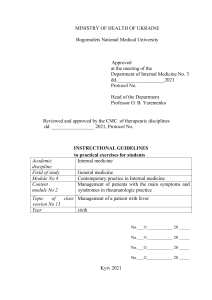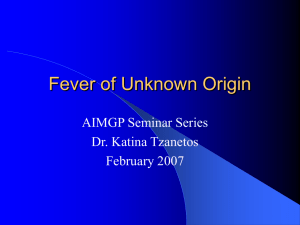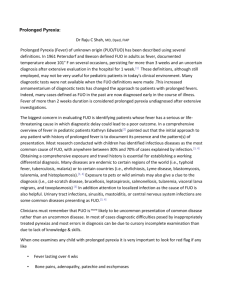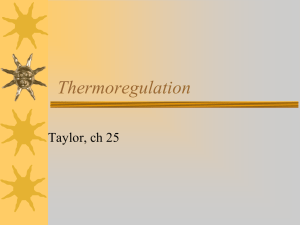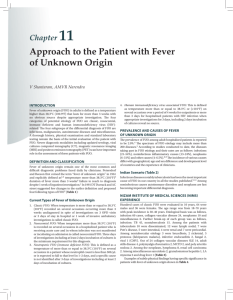Cardinal Manifestations of Disease
advertisement
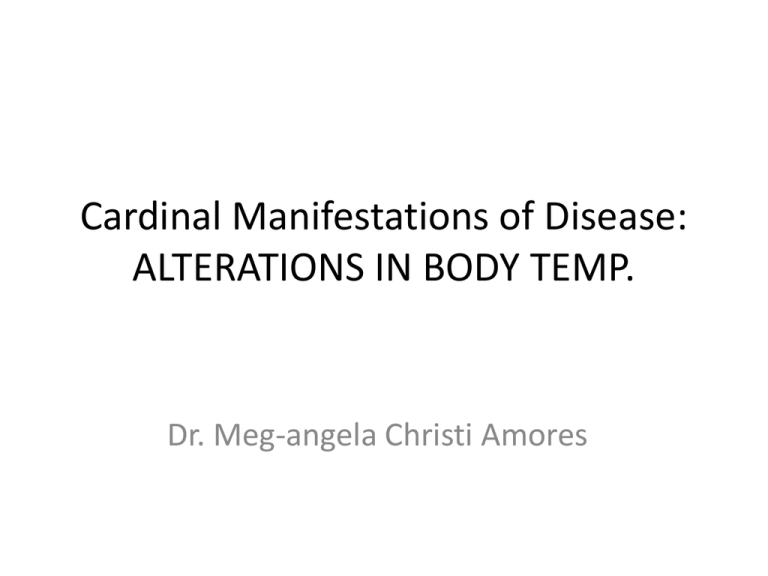
Cardinal Manifestations of Disease: ALTERATIONS IN BODY TEMP. Dr. Meg-angela Christi Amores Fever and Hyperthermia • hypothalamic thermoregulatory center – regulates body temperature (core BT 37 C) • A.M. temperature of >37.2°C (>98.9°F) or a P.M. temperature of >37.7°C (>99.9°F) would define a fever • Rectal temperatures are generally 0.4°C (0.7°F) higher than oral readings Fever • Elevation of body temperature that exceeds the normal daily variation • occurs in conjunction with an increase in the hypothalamic set point • Vasoconstriction in hands and feet, feeling cold, shivers = heat conversion and production • until the temperature of the blood bathing the hypothalamic neurons matches the new thermostat setting Fever • Pathogenesis – Pyrogens – substances that cause fever • Exogenous (microbial products, microbial toxins, or whole microorganisms) • Endogenous a.k.a Cytogenic Pyrogens (IL-1, IL-6, tumor necrosis factor (TNF), ciliary neurotropic factor (CNTF), and interferon (IFN) ) – Elevation of Hypothalamic Set point • levels of prostaglandin E2 (PGE2) are elevated in hypothalamic tissue and the third cerebral ventricle Hyperthermia • uncontrolled increase in body temperature that exceeds the body's ability to lose heat • setting of the hypothalamic thermoregulatory center is unchanged • does not involve pyrogenic molecules • Exogenous heat exposure and endogenous heat production Fever and Rash • presents a diagnostic challenge Measles – Rubeola, rash starts at the hairline 2– 3 days into the illness and moves down the body, sparing the palms and soles Koplik's spots - seen during the first 2 days Rubella – German measles, also spreads from the hairline downward, but tend to clear from originally affected areas as it migrates, and it may be pruritic Fever and Rash • erythema infectiosum (fifth disease) - human parvovirus B19, primarily affects children 3–12 years old; develops after fever has resolved as a bright blanchable erythema on the cheeks – more diffuse rash (often pruritic) appears the next day on the trunk and extremities and then rapidly develops into a lacy reticular eruption that may wax and wane Fever and Rash • systemic lupus erythematosus - typically develop a sharply defined, erythematous eruption in a butterfly distribution on the cheeks (malar rash) • Still's disease - manifests as an evanescent salmon-colored rash on the trunk and proximal extremities that coincides with fever spikes Types of lesions • • • • • Macules - flat lesions defined by an area of changed color Papules - raised, solid lesions <5 mm in diameter plaques ->5 mm in diameter with a flat, plateau-like surface nodules ->5 mm in diameter with a rounded configuration Wheals (urticaria, hives) - papules or plaques that are pale pink and may appear annular (ringlike) as they enlarge • Vesicles (<5 mm) and bullae (>5 mm) are circumscribed, elevated lesions containing fluid • Pustules are raised lesions containing purulent exudate Fever and Rash Fever of Unknown Origin (FUO) Classic Definition • 1) temperatures of >38.3°C (>101°F) on several occasions • (2) a duration of fever of >3 weeks • (3) failure to reach a diagnosis despite 1 week of inpatient investigation Fever of Unknown Origin New Classification • (1) classic FUO • (2) nosocomial FUO • (3) neutropenic FUO • (4) FUO associated with HIV infection Classic FUO • temperatures of >38.3°C on several occasions • a duration of fever of >3 weeks • outpatient visits or 3 days in the hospital without elucidation of a cause or 1 week of "intelligent and invasive" ambulatory investigation • CAUSES: – – – – Undiagnosed – 30% Infections (e.g. Tuberculosis) – 26% Non-infectious Inflammatory (e.g.PR, SLE)– 24% Neoplasms – 12.5% FUO • Nosocomial FUO – more than 50% are infected – Intravascular lines, septic phlebitis, and prostheses are all suspect – Multiple blood, wound, and fluid cultures are mandatory – Threshold for CT scans, ultrasonography, 111In WBC scans, noninvasive venous studies is low FUO • Neutropenic FUO – Neutropenic patients are susceptible to focal bacterial and fungal infections, to bacteremic infections, to infections involving catheters (including septic thrombophlebitis), and to perianal infections – Candida and Aspergillus infections are common – 50–60% of febrile neutropenic patients are infected, and 20% are bacteremic FUO • HIV- associate FUO – Due to HIV alone – due to Mycobacterium avium or Mycobacterium intracellulare, tuberculosis, toxoplasmosis, CMV infection, Pneumocystis infection, salmonellosis, cryptococcosis, histoplasmosis, non-Hodgkin's lymphoma, and (of particular importance) drug fever Hypothermia and Frostbite • Accidental hypothermia - unintentional drop in the body's core temperature below 35°C • Primary accidental hypothermia is a result of the direct exposure of a previously healthy individual to the cold Hypothermia • Heat loss occurs through five mechanisms: – radiation (55–65% of heat loss) – conduction (10–15% of heat loss, but much greater in cold water) – convection (increased in the wind) – Respiration – evaporation (which are affected by the ambient temperature and the relative humidity) Hypothermia • Hypothermia is confirmed by measuring the core temperature, preferably at two sites. • cardiac monitoring should be instituted, along with attempts to limit further heat loss • Supplemental oxygenation is always warranted • NGT, FBC • For the next meeting, read on Cardinal Manifestations of Disease : DYSPNEA • Harrison’s Principles of Internal Medicine 17th edition
